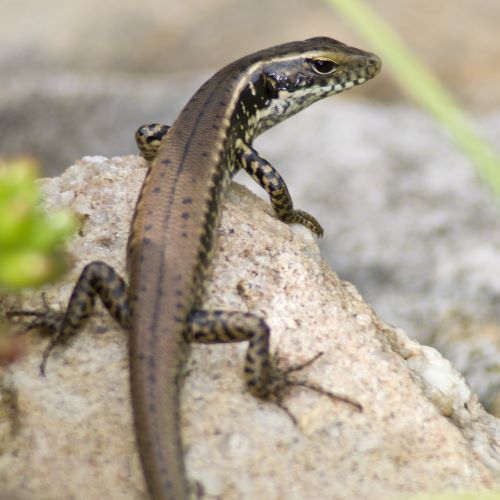24 July 2025

As Australia and the world grapple with global warming and increased bushfire risks, University of South Australia ecologists are turning their attention to the impact of prescribed burning on native animals.
In a new study published in The International Journal of Wildland Fire, researchers investigated the maximum temperatures that lizards could experience during prescribed (controlled) fires in the Mount Lofty Ranges and compared them to their maximum survivable temperatures.
Widespread prescribed burning is undertaken in spring and autumn each year in the Mount Lofty Ranges, a biodiversity hotspot and fire-prone region. Researchers measured surface and shelter temperatures during four prescribed fires and analysed their results alongside the lab-collected ‘critical thermal limits’ of three different species of skinks.
The findings demonstrated that the average temperatures under common shelters like logs and rocks during these fires were 108°C and 53°C respectively, which exceeded the survivable temperature range (37.5°C – 43.0°C) of each type of skink.
While only reptiles were studied, lead researcher and UniSA PhD candidate Shawn Scott says that these temperatures would also threaten the survival of other native animals and that the results can therefore be applied more broadly.
“These conditions dramatically exceed the 60°C threshold for most terrestrial vertebrates,” Scott says.
“Logs and rocks were the most effective shelters for buffering extreme temperatures during prescribed fire in our study.
“However, the maximum temperatures and duration of these conditions may still prove lethal for small vertebrates if prescribed burning is undertaken during conditions that exacerbate fire severity.”
Researchers also discovered that when ambient temperatures on days of prescribed burnings were higher, maximum temperatures beneath the shelters - and the duration at which they stayed lethally hot - also increased.
“Our analysis showed that the temperatures of the fires increased by up to 700°C as ambient temperatures increased from 17°C to 22°C,” Scott says.
“The hotter the fire, the hotter it’s going to be inside or beneath the shelters sought out by small animals during prescribed burnings, making it more difficult for them to survive, especially over an extended period.”
“In terms of shelter quality, rocks and logs maintained the coolest temperatures, showing that they are critical to small animals,” says co-researcher and UniSA wildlife ecologist Associate Professor Sophie (Topa) Petit.
“However, many of those sites still reached temperatures far above what reptiles can withstand. Not all rocks and logs are good enough.”
As climate change increases the risk of bushfires, prescribed burnings are also expected to increase, especially in fire-prone, Mediterranean climates like the Mount Lofty Ranges, other parts of Australia, and also Greece, Italy, Spain and California.
Scott says that animal survival and biodiversity conservation should be prioritised in burning processes, and that his team’s research can help inform relevant strategies not only on the home front but also abroad.
”If lower intensity fires are to be achieved during prescribed burns, they should be undertaken on mild days when ambient temperatures are below 17°C,” he says.
“In Australia, burning does occur on days that are considered mild – between 17°C to 22°C – but our research demonstrates that even in these conditions the maximum temperatures and their duration are high enough to threaten small animals relying on shelters like rocks and logs for protection.
“Second, pre-fire surveys should be conducted to establish the availability and density of shelter sites that may increase the likelihood of animal survival during fire.”
The researchers suggest that larger shelters and below-surface shelters like soil, hollows, and burrows should be examined next, as well as animal movement and mortality during and after fires.
The study, titled ‘Between a rock and a hot place: do surface shelters facilitate survivable conditions for small vertebrates during prescribed fire?’ is available online. DOI:10.1071/WF24184
…………………………………………………………………………………………………………………………
Contact for interview: Shawn Scott E: Shawn.Scott@unisa.edu.au
Media contacts: Candy Gibson M: +61 434 605 142 E: Candy.Gibson@unisa.edu.au; Josh Owen-Thomas E: Josh.Owen-Thomas@unisa.edu.au



